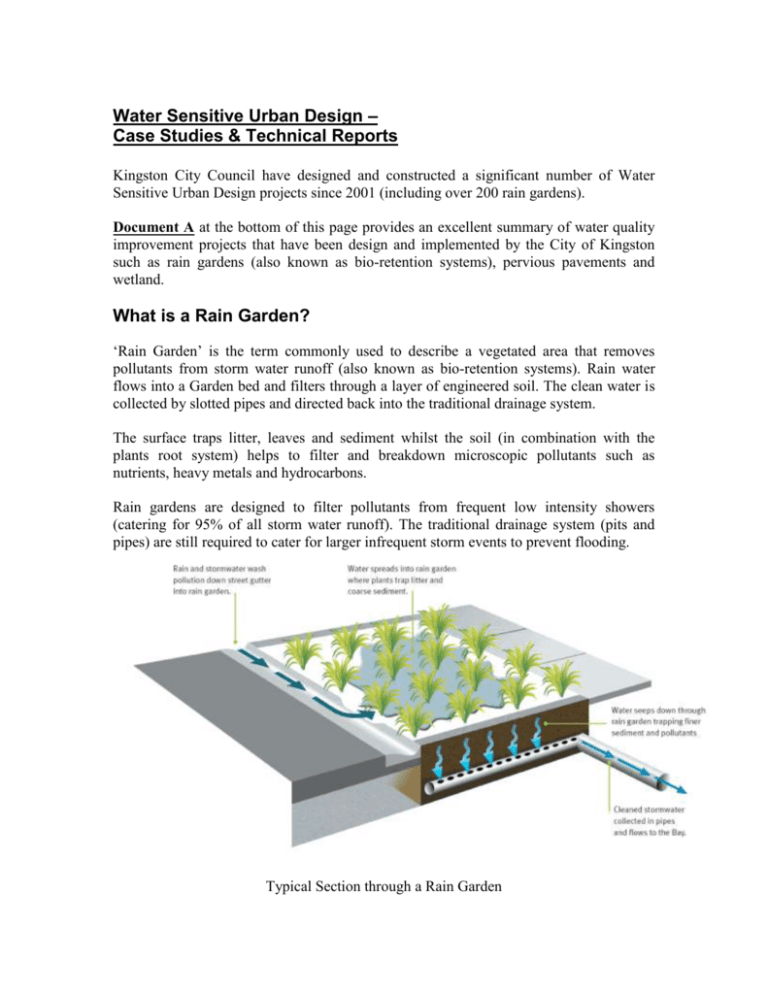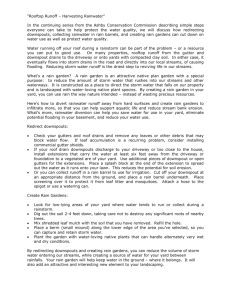Water Sensitive Urban Design
advertisement

Water Sensitive Urban Design – Case Studies & Technical Reports Kingston City Council have designed and constructed a significant number of Water Sensitive Urban Design projects since 2001 (including over 200 rain gardens). Document A at the bottom of this page provides an excellent summary of water quality improvement projects that have been design and implemented by the City of Kingston such as rain gardens (also known as bio-retention systems), pervious pavements and wetland. What is a Rain Garden? ‘Rain Garden’ is the term commonly used to describe a vegetated area that removes pollutants from storm water runoff (also known as bio-retention systems). Rain water flows into a Garden bed and filters through a layer of engineered soil. The clean water is collected by slotted pipes and directed back into the traditional drainage system. The surface traps litter, leaves and sediment whilst the soil (in combination with the plants root system) helps to filter and breakdown microscopic pollutants such as nutrients, heavy metals and hydrocarbons. Rain gardens are designed to filter pollutants from frequent low intensity showers (catering for 95% of all storm water runoff). The traditional drainage system (pits and pipes) are still required to cater for larger infrequent storm events to prevent flooding. Typical Section through a Rain Garden Recent Council Projects Stawell St, Mentone Rain gardens were upgraded to our current design in 2008 at a cost of $68,000 (or $6,800 per rain garden). This design incorporates the use of attractive rocks, more interesting shapes, the use of exposed aggregate concrete paving abutting the kerb (to address parking concerns) and the subtle use of treated pine terracing to avoid steep grades Peter Scullin Carpark, Mordialloc This water sensitive carpark was designed to use stormwater runoff to irrigate the landscaping and treat the surplus rainwater via bio-retention swales. Bear St, Mordialloc Bear St was reconstructed in 2007 as a narrower curvilinear road. The layout specifically designed to create space within the nature strips for 5 rain gardens and a large 70m long bio-retention retarding basin (pictured below). The bio-retention retarding basin has the multi-purpose function of reducing pollutant load, providing flood mitigation and enhancing the overall streetscape. Warren Rd, Parkdale Warren Rd was completely reconstructed in 2007 to upgrade the road pavement, address traffic issues and treat stormwater runoff. The project incorporated an unusual rain garden within a kerb outstand using rock walls to minimise erosion. The treatment was designed to look as natural as possible and minimise maintenance. Coleman Rd, Aspendale The beach at Aspendale was suffering from erosion of the sand dunes and three unattractive stormwater outlets. This project involved the construction of an attractive erosion control wall and the removal of the pipes by redirecting the stormwater runoff into soakage wells (primary treatment) and then into large bioretention swales (secondary treatment). Constructed during 2008 in partnership with the Department of Sustainability & Environment. City of Kingston Rain Garden Bus Tours The City of Kingston offers half day bus tours of our rain garden projects in partnership with Clearwater. For further information, please contact : Alan West Team Leader – Engineering Design City of Kingston alan.west@kingston.vic.gov.au Download Files Please refer to the following documents for more information about Council’s projects and related information on water sensitive urban design: Document A - A snapshot of projects Document B - USA Study Tour Report Document C - USA Study Tour Photos Document D - Stawell St Case Study Document E – Example Rain Garden Design Plans (New) A Recent Magazine Article The City of Kingston (a southern suburb of Melbourne, Victoria) has retrofitted over 130 rain gardens into residential nature strips across the City and is broadly recognized both locally and internationally as an industry leader in this field of water sensitive urban design. Much of this work has been overseen by Council officer Alan West who manages the City of Kingston’s design team. ‘Rain Garden’ is the term commonly used to describe a depressed vegetated area that removes pollutants from storm water runoff (also known as a bio-retention system). Alan explains that Kingston Council has focused a lot of its efforts over the last two years on addressing community concerns about rain gardens, improving their aesthetics and developing effective maintenance practices. Alan maintains that the environmental benefits of rain gardens are rarely questioned but that many Councils question the longer-term practical implications of the system, their cost, and how to manage these assets effectively. “While most industry advice is based on sound water quality objectives and design principles, not everyone has a full appreciation of other considerations such as community expectations, public safety, overall streetscape aesthetics, parking needs, maintenance practices and budgetary constraints,” said Alan West. “In our experience when discussing the challenges associated with implementing successful rain gardens, the conversation quickly changes to the perceived lack of information on maintenance requirements, whole of life costs and the community acceptance of ‘new’ ideas.” To address these barriers, the City of Kingston’s engineers embarked upon a detailed community consultation program during 2007. Typical responses from residents included: A lack of understanding or appreciation of their function. An impression that the plants were unattractive. A perception that steep batters or retaining walls may be dangerous. An inability for elderly residents to safely exit the passenger side of a parked vehicle. Difficulties with mowing their lawn around the rain gardens. Having engaged with the community, Kingston Council’s next step was to replace their old rain gardens with new and improved versions which are now being maintained to a ‘showcase’ standard. “Our current rain garden designs are proving to be very popular,” said Alan. “Our community now appreciates and values the unique urban design elements of rain gardens which have been designed to be practical and enhance the overall aesthetics of the streetscape. These improvements included the use of attractive rocks, more interesting shapes, the use of exposed aggregate concrete paving abutting the kerb (to address parking concerns) and the subtle use of treated pine terracing to avoid steep grades.” Kingston’s latest set of 30 rain gardens were progressively installed and landscaped between September 2007 and February 2008 at a total construction cost of $207,000 (an average cost of $6,900 per rain garden). After the period of trial and error by Kingston Council, other local governments are now supporting the installation of rain gardens – either as part of planning permit applications or implemented under each Council’s capital works program. In summary, Alan West said he believes that successful water sensitive urban design requires a long term commitment from a range of Council departments, particularly those responsible for planning, design, construction and maintenance. “It is vital that everyone involved in the project clearly understands their role and responsibilities including community consultation, regular maintenance programs, performance inspections, GIS mapping and budgeting. Rain gardens need to be treated as another important infrastructure asset that needs to be recorded, assessed and managed effectively,” he said. “Involving a broad cross section of staff also assists with developing an integrated approach to total water management and funding decisions that appropriately address flood mitigation objectives, pipe maintenance, water conservation as well as storm water quality and reuse objectives.” The City of Kingston’s results have exceeded all expectations and resulted in the Council receiving Awards at a recent 2008 Storm water Industry Association (Victoria) event that recognized storm water excellence (see attached story and photo). The City of Kingston has produced an attractive 4 page educational brochure which clearly explains how rain gardens work and why it’s so important to protect our bay and waterways from storm water pollution. And a final word of advice from Alan…… “don’t be obsessed with achieving prescribed best practice pollution reduction targets with your rain gardens. Installing an appropriately designed rain garden that compliments the streetscape (and balances competing needs within a busy environment) is likely to yield better results than installing an optimistic rain garden that may become unpopular with residents (and therefore unsustainable in the long term). Every rain garden contributes to the health of our waterways and bays and also plays a strong role in educating the community about the water cycle and how they can contribute to keeping waterways healthy”.







